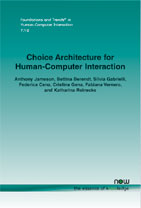Choice Architecture for Human-Computer Interaction
By Anthony Jameson, DFKI, German Research Center for Artificial Intelligence, Germany, jameson@dfki.de | Bettina Berendt, Catholic University Leuven, Belgium, Bettina.Berendt@cs.kuleuven.be | Silvia Gabrielli, CREATE-NET, Italy, silvia.gabrielli@create-net.org | Federica Cena, University of Torino, Italy, cena@di.unito.it | Cristina Gena, University of Torino, Italy, cgena@di.unito.it | Fabiana Vernero, University of Torino, Italy, vernerof@di.unito.it | Katharina Reinecke, University of Michigan, USA, reinecke@umich.edu
Abstract
People in human–computer interaction have learned a great deal about how to persuade and influence users of computing technology. They have much less well-founded knowledge about how to help users choose for themselves. It’s time to correct this imbalance. A first step is to organize the vast amount of relevant knowledge that has been built up in psychology and related fields in terms of two comprehensive but easy-to-remember models: The ASPECT model answers the question “How do people make choices?“ by describing six choice patterns that choosers apply alternately or in combination, based on Attributes, Social influence, Policies, Experience, Consequences, and Trial and error. The ARCADE model answers the question “How can we help people make better choices?“ by describing six general high-level strategies for supporting choice: Access information and experience, Represent the choice situation, Combine and compute, Advise about processing, Design the domain, and Evaluate on behalf of the chooser. These strategies can be implemented with straightforward interaction design, but for each one there are also specifically relevant technologies. Combining these two models, we can understand virtually all existing and possible approaches to choice support as the application of one or more of the ARCADE strategies to one or more of the ASPECT choice patterns.
After introducing the idea of choice architecture for human–computer interaction and the key ideas of the ASPECT and ARCADE models, we discuss each of the Aspect patterns in detail and show how the high-level ARCADE strategies can be applied to it to yield specific tactics. We then apply the two models in the domains of online communities and privacy. Most of our examples concern choices about the use of computing technology, but the models are equally applicable to everyday choices made with the help of computing technology.
Choice Architecture for Human-Computer Interaction
People in human-computer interaction have learned a great deal about how to persuade and influence users of computing technology. They have much less well-founded knowledge about how to help users choose for themselves. This publication aims to correct this imbalance by organizing the vast amount of relevant knowledge that has been built up in psychology and related fields in terms of two models that are intended to be accessible, useful, and memorable to researchers and practitioners in human-computer interaction. The ASPECT model answers the question “How do people make choices?” by describing six choice patterns that choosers apply alternately or in combination. The ARCADE model answers the question “How can we help people make better choices?” by describing six high-level strategies for supporting choice and ways of applying them with the help of interaction design and computing technologies. We discuss each of the ASPECT patterns in detail and show how the high-level Arcade strategies can be applied to it to yield specific tactics. Separate sections illustrate how the two models can provide new perspectives on the choices that people make in connection with online communities and privacy, respectively. Most of our examples concern choices about the use of computing technology, but the models are equally applicable to other everyday choices made with the help of computing technology. Extensive references enable readers to consult the original research literature on topics of special interest to them.
